Investigations of the Mechanical Properties and Durability of Reactive Powder Concrete Containing Waste Fly Ash
Abstract
:1. Introduction
2. Materials and Methods
2.1. Raw Materials
2.2. Samples Preparation and Measurement Methods
3. Results and Discussion
3.1. The Flowability
3.2. The Mechanical Strengths
3.3. NaCl Freeze–Thaw Tests
4. Conclusions
Author Contributions
Funding
Data Availability Statement
Conflicts of Interest
References
- Avila-López, U.; Almanza-Robles, J.M.; Escalante-García, J.I. Investigation of Novel Waste Glass and Limestone Binders Using Statistical Methods. Constr. Build. Mater. 2015, 82, 296–303. [Google Scholar] [CrossRef]
- Chen, L.; Wang, Y.-S.; Wang, L.; Zhang, Y.; Li, J.; Tong, L.; Hu, Q.; Dai, J.-G.; Tsang, D.C.W. Stabilisation/Solidification of Municipal Solid Waste Incineration Fly Ash by Phosphate-Enhanced Calcium Aluminate Cement. J. Hazard. Mater. 2021, 408, 124404. [Google Scholar] [CrossRef] [PubMed]
- Ivan Diaz-Loya, E.; Allouche, E.N.; Eklund, S.; Joshi, A.R.; Kupwade-Patil, K. Toxicity Mitigation and Solidification of Municipal Solid Waste Incinerator Fly Ash Using Alkaline Activated Coal Ash. Waste Manag. 2012, 32, 1521–1527. [Google Scholar] [CrossRef]
- Chandler, A.J.; Eighmy, T.T.; Hjelmar, O.; Kosson, D.S.; Sawell, S.E.; Vehlow, J.; Sloot, H.A.; van der Hartlén, J. Municipal Solid Waste Incinerator Residues; Elsevier: Amsterdam, The Netherlands, 1997; ISBN 978-0-08-053718-4. [Google Scholar]
- Adamu, M.; Mohammed, B.S.; Shafiq, N.; Liew, M.S. Durability Performance of High Volume Fly Ash Roller Compacted Concrete Pavement Containing Crumb Rubber and Nano Silica. Int. J. Pavement Eng. 2020, 21, 1437–1444. [Google Scholar] [CrossRef]
- Diliberto, C.; Meux, E.; Diliberto, S.; Garoux, L.; Marcadier, E.; Rizet, L.; Lecomte, A. A Zero-Waste Process for the Management of MSWI Fly Ashes: Production of Ordinary Portland Cement. Environ. Technol. 2020, 41, 1199–1208. [Google Scholar] [CrossRef] [PubMed]
- Aubert, J.E.; Husson, B.; Sarramone, N. Utilization of Municipal Solid Waste Incineration (MSWI) Fly Ash in Blended Cement: Part 1: Processing and Characterization of MSWI Fly Ash. J. Hazard. Mater. 2006, 136, 624–631. [Google Scholar] [CrossRef]
- Qiao, X.C.; Tyrer, M.; Poon, C.S.; Cheeseman, C.R. Novel Cementitious Materials Produced from Incinerator Bottom Ash. Resour. Conserv. Recycl. 2008, 52, 496–510. [Google Scholar] [CrossRef]
- Aubert, J.E.; Husson, B.; Vaquier, A. Use of Municipal Solid Waste Incineration Fly Ash in Concrete. Cem. Concr. Res. 2004, 34, 957–963. [Google Scholar] [CrossRef]
- Polettini, A.; Pomi, R.; Sirini, P.; Testa, F. Properties of Portland Cement—Stabilised MSWI Fly Ashes. J. Hazard. Mater. 2001, 88, 123–138. [Google Scholar] [CrossRef]
- Saikia, N.; Kato, S.; Kojima, T. Production of Cement Clinkers from Municipal Solid Waste Incineration (MSWI) Fly Ash. Waste Manag. 2007, 27, 1178–1189. [Google Scholar] [CrossRef]
- Kikuchi, R. Recycling of Municipal Solid Waste for Cement Production: Pilot-Scale Test for Transforming Incineration Ash of Solid Waste into Cement Clinker. Resour. Conserv. Recycl. 2001, 31, 137–147. [Google Scholar] [CrossRef]
- Li, X.-G.; Lv, Y.; Ma, B.-G.; Chen, Q.-B.; Yin, X.-B.; Jian, S.-W. Utilization of Municipal Solid Waste Incineration Bottom Ash in Blended Cement. J. Clean. Prod. 2012, 32, 96–100. [Google Scholar] [CrossRef]
- Rehman, A.U.; Lee, S.-M.; Kim, J.-H. Use of Municipal Solid Waste Incineration Ash in 3D Printable Concrete. Process Saf. Environ. Prot. 2020, 142, 219–228. [Google Scholar] [CrossRef]
- Alderete, N.M.; Joseph, A.M.; Van den Heede, P.; Matthys, S.; De Belie, N. Effective and Sustainable Use of Municipal Solid Waste Incineration Bottom Ash in Concrete Regarding Strength and Durability. Resour. Conserv. Recycl. 2021, 167, 105356. [Google Scholar] [CrossRef]
- Tang, P.; Florea, M.V.A.; Spiesz, P.; Brouwers, H.J.H. Application of Thermally Activated Municipal Solid Waste Incineration (MSWI) Bottom Ash Fines as Binder Substitute. Cem. Concr. Compos. 2016, 70, 194–205. [Google Scholar] [CrossRef]
- Bertolini, L.; Carsana, M.; Cassago, D.; Quadrio Curzio, A.; Collepardi, M. MSWI Ashes as Mineral Additions in Concrete. Cem. Concr. Res. 2004, 34, 1899–1906. [Google Scholar] [CrossRef]
- Shi, H.-S.; Kan, L.-L. Leaching Behavior of Heavy Metals from Municipal Solid Wastes Incineration (MSWI) Fly Ash Used in Concrete. J. Hazard. Mater. 2009, 164, 750–754. [Google Scholar] [CrossRef]
- Rémond, S.; Pimienta, P.; Bentz, D.P. Effects of the Incorporation of Municipal Solid Waste Incineration Fly Ash in Cement Pastes and Mortars: I. Experimental Study. Cem. Concr. Res. 2002, 32, 303–311. [Google Scholar] [CrossRef]
- Luna Galiano, Y.; Fernández Pereira, C.; Vale, J. Stabilization/Solidification of a Municipal Solid Waste Incineration Residue Using Fly Ash-Based Geopolymers. J. Hazard. Mater. 2011, 185, 373–381. [Google Scholar] [CrossRef]
- Mayhoub, O.A.; Nasr, E.-S.A.R.; Ali, Y.A.; Kohail, M. The Influence of Ingredients on the Properties of Reactive Powder Concrete: A Review. Ain Shams Eng. J. 2021, 12, 145–158. [Google Scholar] [CrossRef]
- Cai, Z.; Wang, H. Influence of NaCl Freeze–Thaw Cycles on the Mechanical Strength of Reactive Powder Concrete with the Assembly Unit of Sulphoaluminate Cement and Ordinary Portland Cement. Coatings 2021, 11, 1238. [Google Scholar] [CrossRef]
- Sadrekarimi, A. Development of a Light Weight Reactive Powder Concrete. J. Adv. Concr. Technol. 2004, 2, 409–417. [Google Scholar] [CrossRef] [Green Version]
- Yu, J.; Zhang, A.; Zhang, L.; Wang, Q.; Li, K.; Wang, H. Study on the Performance of Low Water-Binder Ratio Cement Mortar with Excavated Soil Exposed to NaCl Freeze-Thaw Environment. Mater. Res. Express 2021, 8, 095511. [Google Scholar] [CrossRef]
- Richard, P.; Cheyrezy, M. Composition of Reactive Powder Concretes. Cem. Concr. Res. 1995, 25, 1501–1511. [Google Scholar] [CrossRef]
- GB175-2007; Common Portland Cement. The State Bureau of Quality and Technical Supervision: Beijing, China, 2007.
- Wang, H.; Shi, F.; Shen, J.; Zhang, A.; Zhang, L.; Huang, H.; Liu, J.; Jin, K.; Feng, L.; Tang, Z. Research on the Self-Sensing and Mechanical Properties of Aligned Stainless Steel Fiber-Reinforced Reactive Powder Concrete. Cem. Concr. Compos. 2021, 119, 104001. [Google Scholar] [CrossRef]
- Wang, H.; Gao, X.; Liu, J.; Ren, M.; Lu, A. Multi-Functional Properties of Carbon Nanofiber Reinforced Reactive Powder Concrete. Constr. Build. Mater. 2018, 187, 699–707. [Google Scholar] [CrossRef]
- Cui, L.; Wang, H. Research on the Mechanical Strengths and the Following Corrosion Resistance of Inner Steel Bars of RPC with Rice Husk Ash and Waste Fly Ash. Coatings 2021, 11, 1480. [Google Scholar] [CrossRef]
- Cui, L.; Wang, H. Influence of Waste Fly Ash on the Rheological Properties of Fresh Cement Paste and the Following Electrical Performances and Mechanical Strengths of Hardened Specimens. Coatings 2021, 11, 1558. [Google Scholar] [CrossRef]
- GB/T 2419-2005; Test Methods for Fluidity of Cement Mortar. The State Bureau of Quality and Technical Supervision: Beijing, China, 2005.
- GB/T50081-2019; Standard for Test Method of Concrete Physical and Mechanical Properties. The State Bureau of Quality and Technical Supervision: Beijing, China, 2019.
- GB/T 17671-1999; Method of Testing Cements-Determination of Strength. The State Bureau of Quality and Technical Supervision: Beijing, China, 1999.
- GB/T 50082-2009; Standard for Test Method of Long-Term Performance and Durability of Ordinary Concrete. Ministry of Housing and Urban-Rural Development: Beijing, China, 2009.
- El-eswed, B.I. Chemical Evaluation of Immobilization of Wastes Containing Pb, Cd, Cu and Zn in Alkali-Activated Materials: A Critical Review. J. Environ. Chem. Eng. 2020, 8, 104194. [Google Scholar] [CrossRef]
- Huang, G.; Wang, H.; Shi, F. Coupling Effect of Salt Freeze-Thaw Cycles and Carbonation on the Mechanical Performance of Quick Hardening Sulphoaluminate Cement-Based Reactive Powder Concrete with Basalt Fibers. Coatings 2021, 11, 1142. [Google Scholar] [CrossRef]
- Huang, H.; Gao, X.; Wang, H.; Ye, H. Influence of Rice Husk Ash on Strength and Permeability of Ultra-High Performance Concrete. Constr. Build. Mater. 2017, 149, 621–628. [Google Scholar] [CrossRef]
- Huang, G.; Yuan, L.; Ji, Y.; Liu, B.; Xu, Z. Cooperative Action and Compatibility between Portland Cement and MSWI Bottom Ash Alkali-Activated Double Gel System Materials. Constr. Build. Mater. 2019, 209, 445–453. [Google Scholar] [CrossRef]
- Ferraro, A.; Farina, I.; Race, M.; Colangelo, F.; Cioffi, R.; Fabbricino, M. Pre-Treatments of MSWI Fly-Ashes: A Comprehensive Review to Determine Optimal Conditions for Their Reuse and/or Environmentally Sustainable Disposal. Rev. Environ. Sci. BioTechnol. 2019, 18, 453–471. [Google Scholar] [CrossRef]
- Hwang, Y.-H.; Kim, D.-G.; Shin, H.-S. Mechanism Study of Nitrate Reduction by Nano Zero Valent Iron. J. Hazard. Mater. 2011, 185, 1513–1521. [Google Scholar] [CrossRef]
- Kjeldsen, P.; Barlaz, M.A.; Rooker, A.P.; Baun, A.; Ledin, A.; Christensen, T.H. Present and Long-Term Composition of MSW Landfill Leachate: A Review. Crit. Rev. Environ. Sci. Technol. 2002, 32, 297–336. [Google Scholar] [CrossRef]
- Ormellese, M.; Berra, M.; Bolzoni, F.; Pastore, T. Corrosion Inhibitors for Chlorides Induced Corrosion in Reinforced Concrete Structures. Cem. Concr. Res. 2006, 36, 536–547. [Google Scholar] [CrossRef]
- Hong, X.; Wang, H.; Shi, F. Influence of NaCl Freeze Thaw Cycles and Cyclic Loading on the Mechanical Performance and Permeability of Sulphoaluminate Cement Reactive Powder Concrete. Coatings 2020, 10, 1227. [Google Scholar] [CrossRef]
- Wang, H.; Gao, X.; Liu, J. Effects of Salt Freeze-Thaw Cycles and Cyclic Loading on the Piezoresistive Properties of Carbon Nanofibers Mortar. Constr. Build. Mater. 2018, 177, 192–201. [Google Scholar] [CrossRef]
- Cai, G.; Zhao, J. Application of Sulphoaluminate Cement to Repair Deteriorated Concrete Members in Chloride Ion Rich Environment-A Basic Experimental Investigation of Durability Properties. KSCE J. Civ. Eng. 2016, 20, 2832–2841. [Google Scholar] [CrossRef] [Green Version]
- Liu, R.; Jiang, L.; Xu, J.; Xiong, C.; Song, Z. Influence of Carbonation on Chloride-Induced Reinforcement Corrosion in Simulated Concrete Pore Solutions. Constr. Build. Mater. 2014, 56, 16–20. [Google Scholar] [CrossRef]
- Yoon, I.-S. Simple Approach to Calculate Chloride Diffusivity of Concrete Considering Carbonation. Comput. Concr. 2009, 6, 1–18. [Google Scholar] [CrossRef]
- Gartner, E.; Hirao, H. A Review of Alternative Approaches to the Reduction of CO2 Emissions Associated with the Manufacture of the Binder Phase in Concrete. Cem. Concr. Res. 2015, 78, 126–142. [Google Scholar] [CrossRef] [Green Version]
- Wang, H.; Zhang, A.; Zhang, L.; Liu, J.; Han, Y.; Wang, J. Research on the Influence of Carbonation on the Content and State of Chloride Ions and the Following Corrosion Resistance of Steel Bars in Cement Paste. Coatings 2020, 10, 1071. [Google Scholar] [CrossRef]
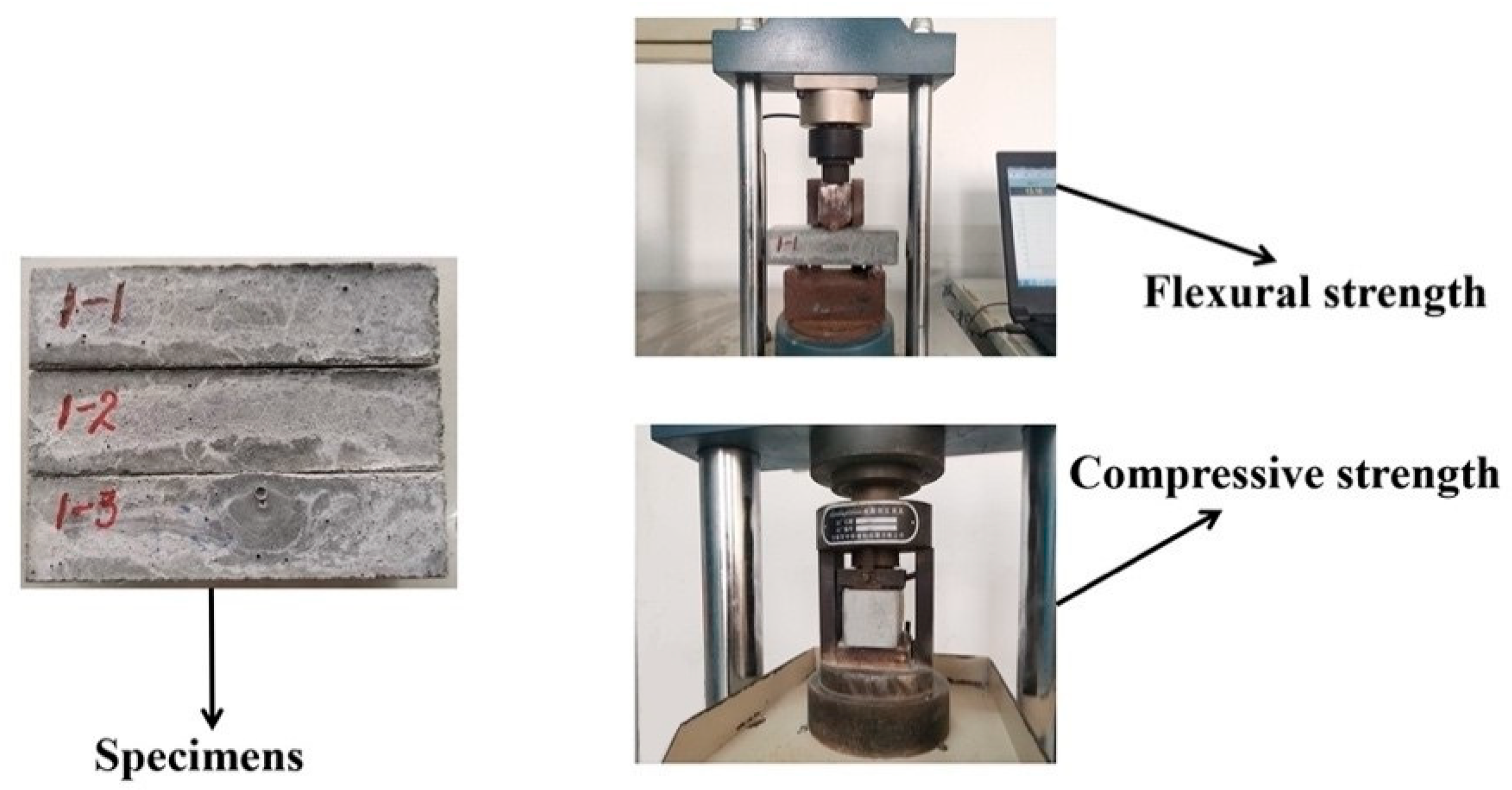
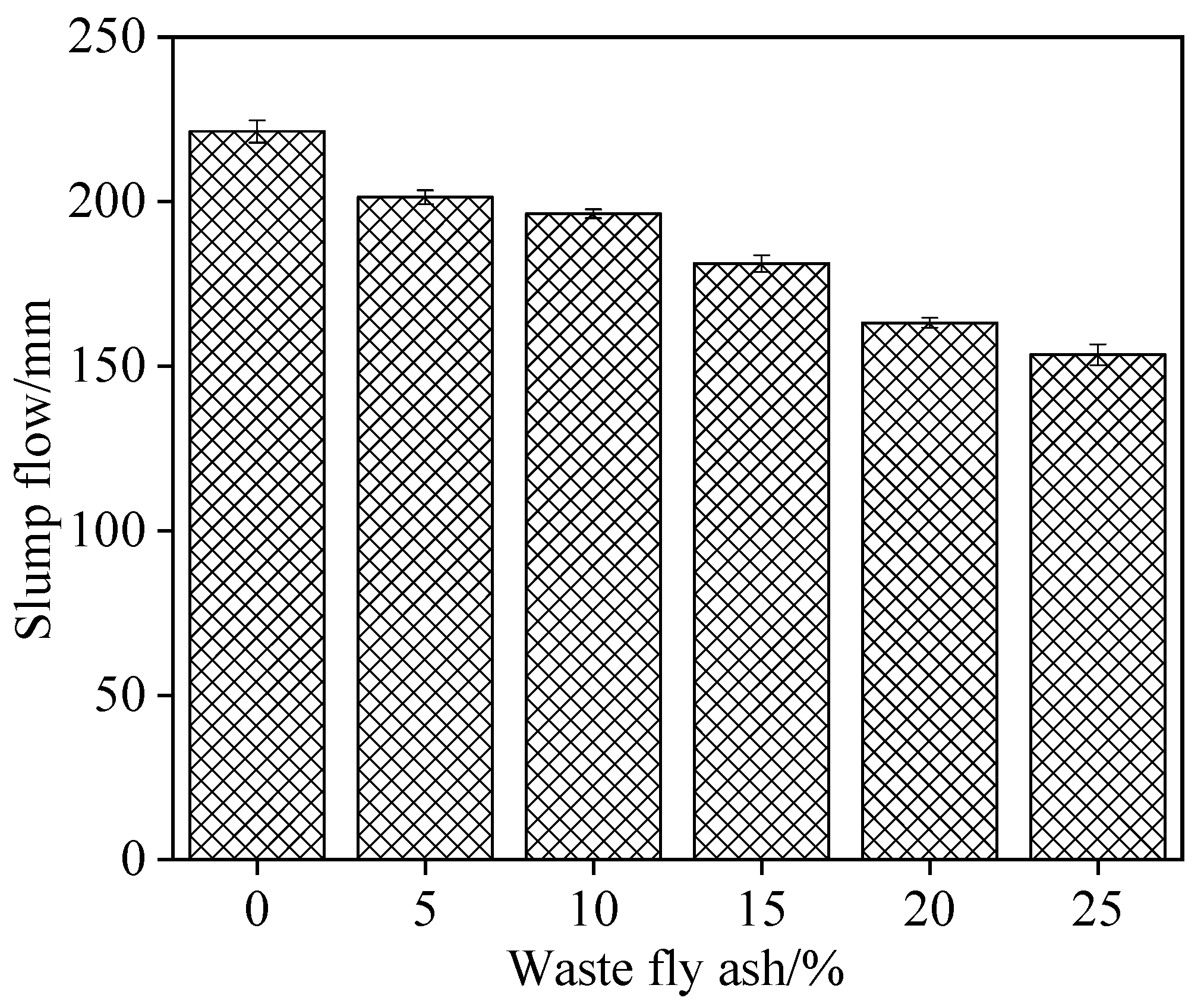
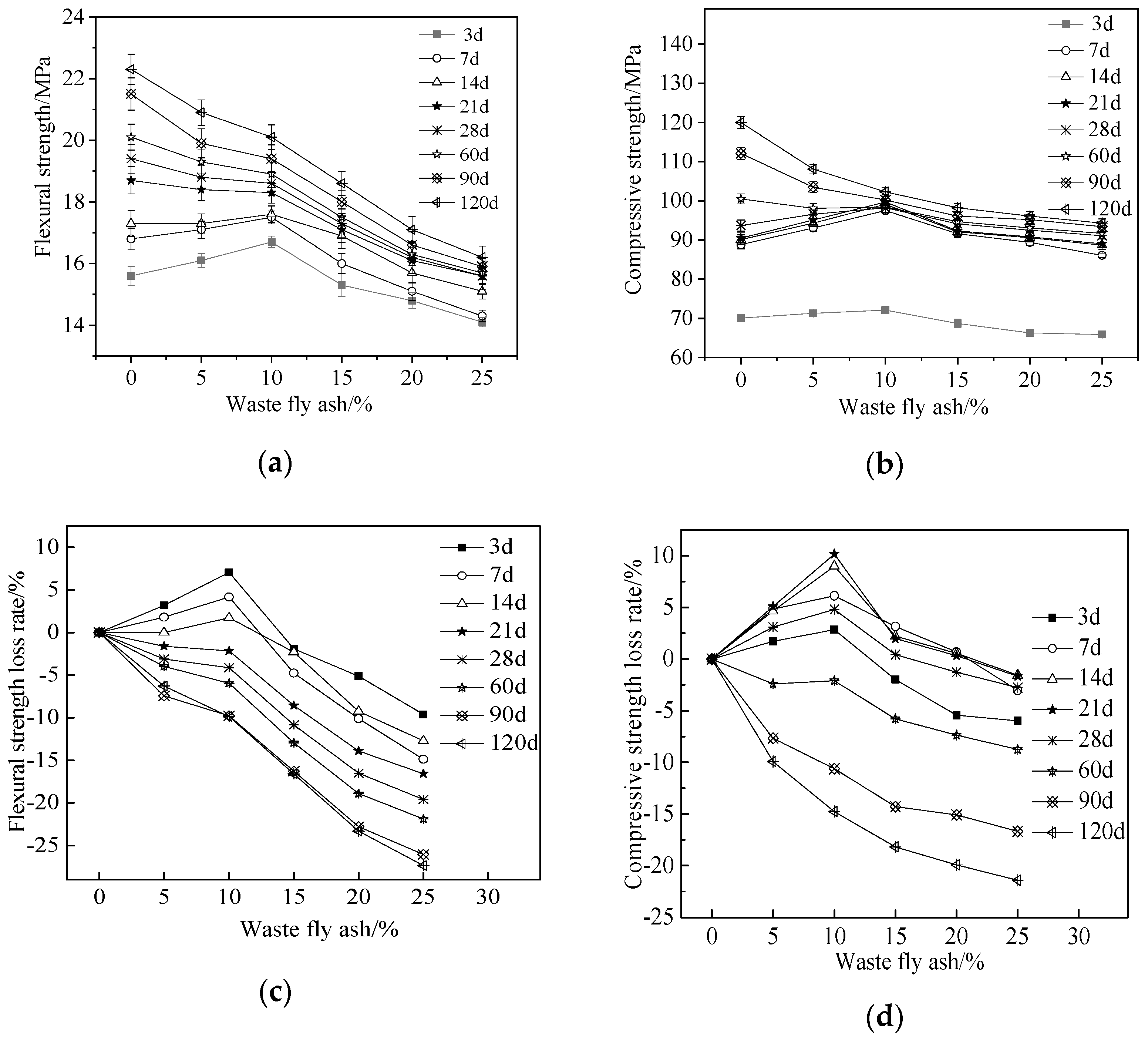
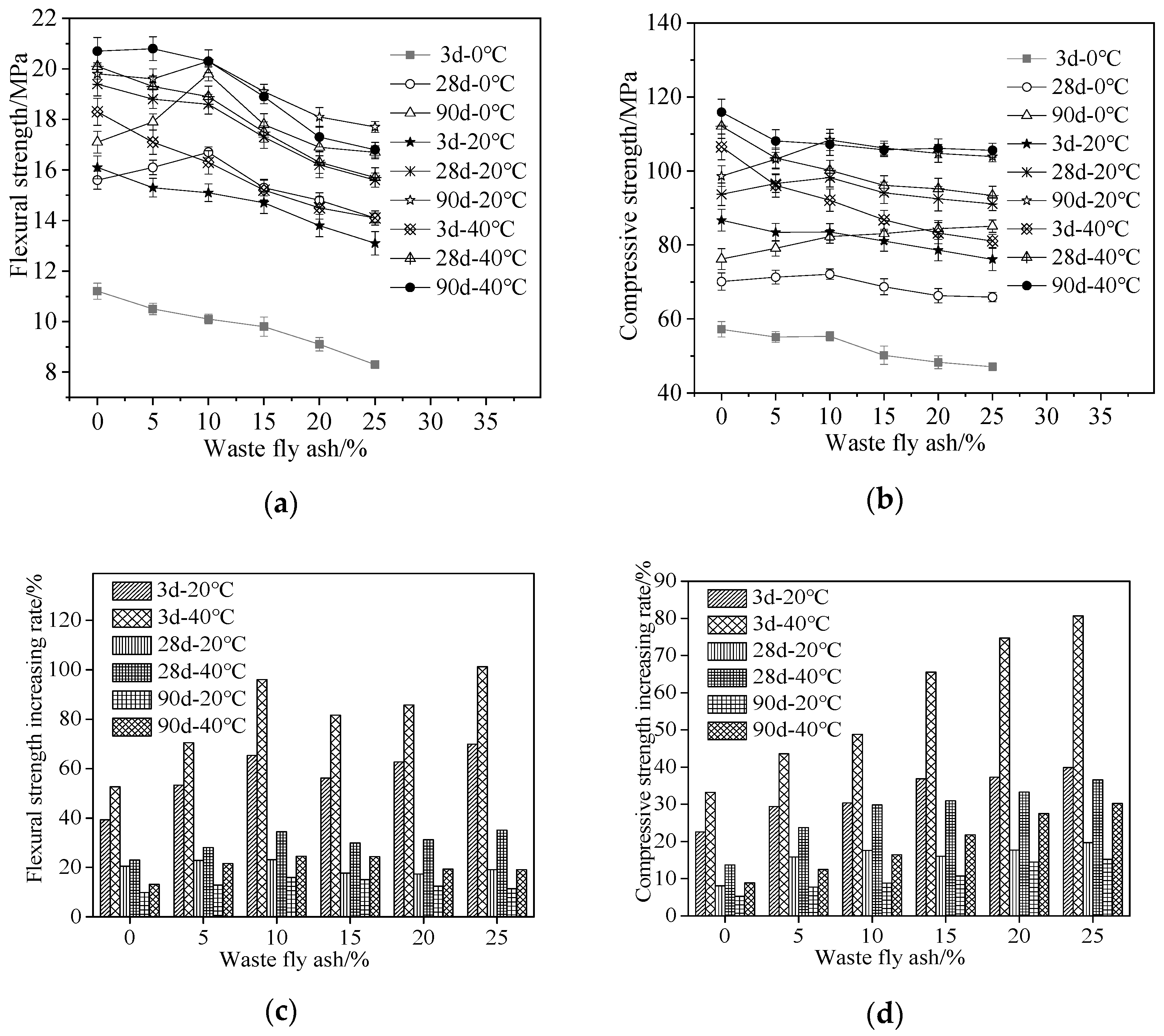



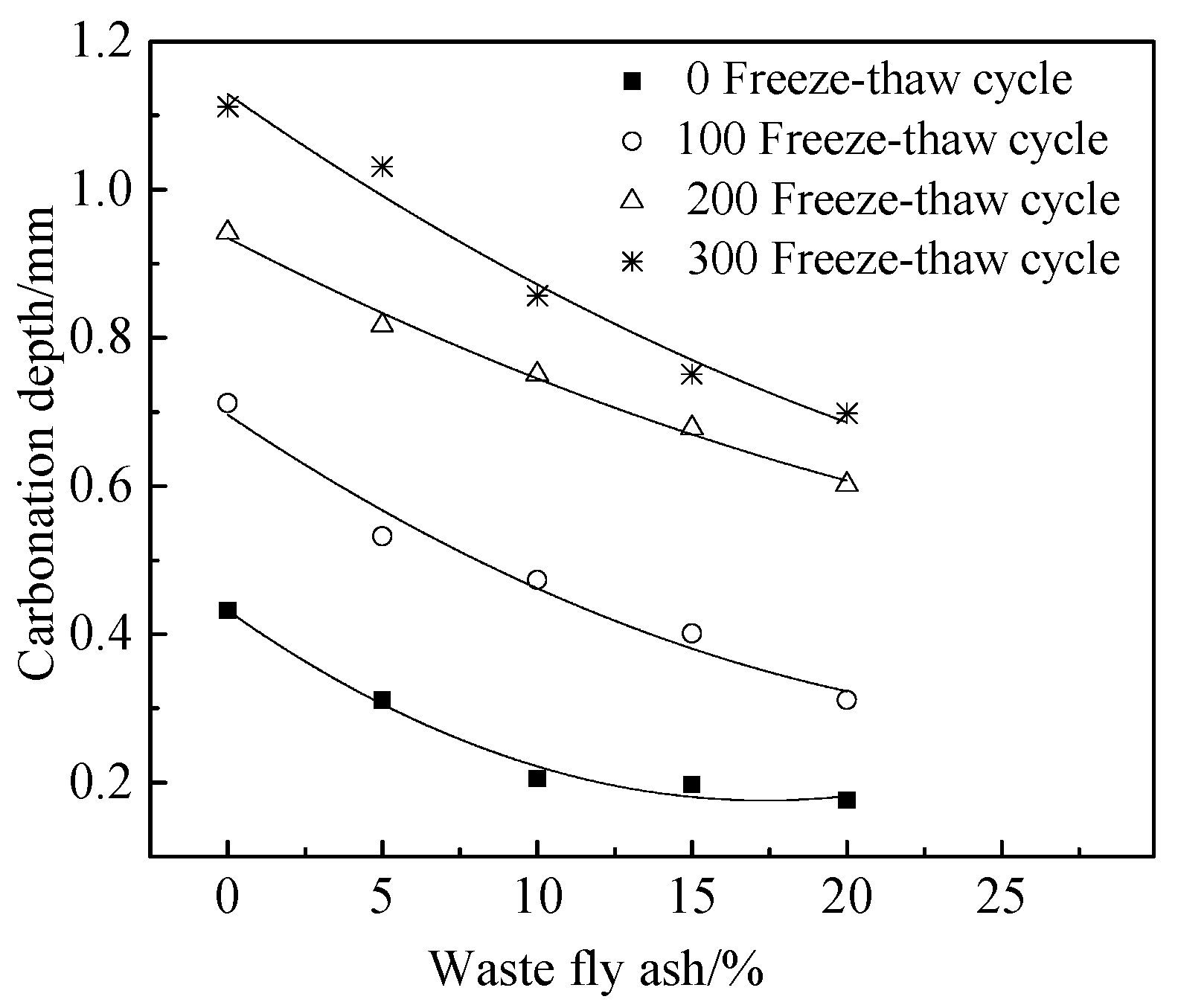

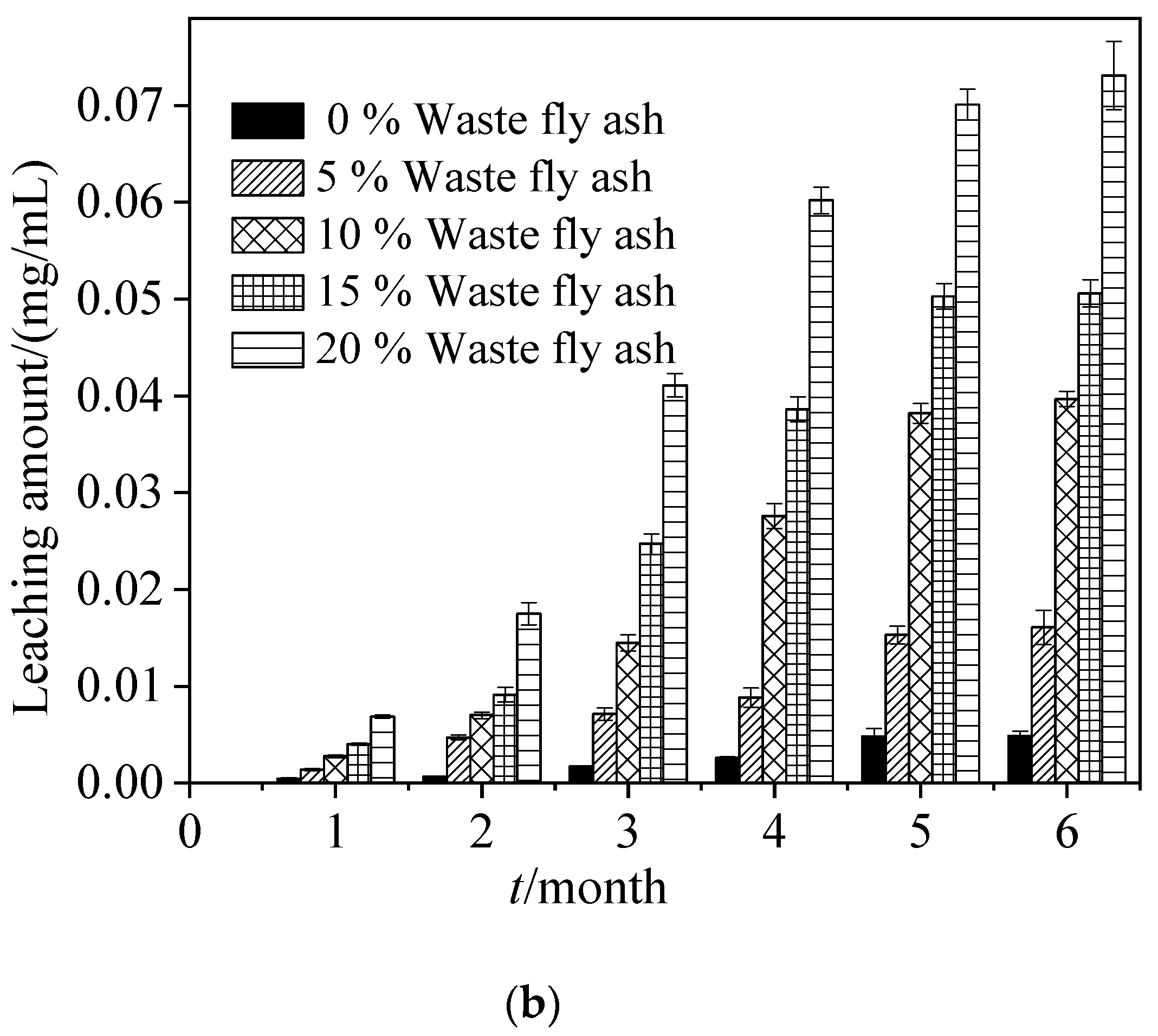

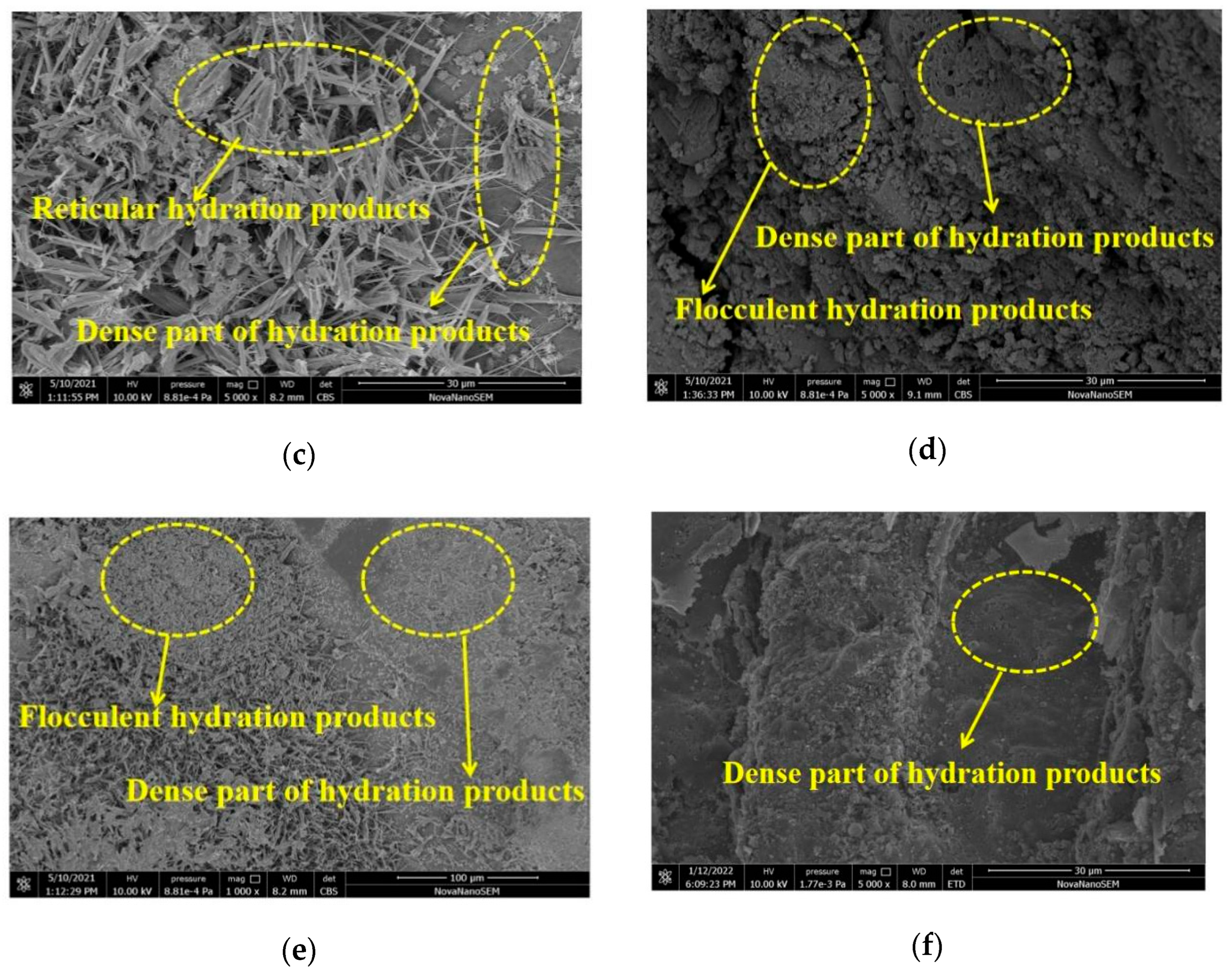
| Water | OPC | WFA | SF | GGBS | Quartz Sand | Water Reducer |
|---|---|---|---|---|---|---|
| 244.4 | 740.7 | 0 | 370.3 | 111.1 | 977.9 | 16.3 |
| 244.4 | 679.6 | 61.1 | 370.3 | 111.1 | 977.9 | 16.3 |
| 244.4 | 618.5 | 122.2 | 370.3 | 111.1 | 977.9 | 16.3 |
| 244.4 | 557.4 | 183.3 | 370.3 | 111.1 | 977.9 | 16.3 |
| 244.4 | 496.3 | 244.4 | 370.3 | 111.1 | 977.9 | 16.3 |
| 244.4 | 435.2 | 305.5 | 370.3 | 111.1 | 977.9 | 16.3 |
| Types | SiO2 | Al2O3 | FexOy | MgO | CaO | SO3 | K2O | Na2O | Ti2O | CdO | Cr2O3 | PbO | CuO | ZnO | Loss on Ignition |
|---|---|---|---|---|---|---|---|---|---|---|---|---|---|---|---|
| WFA | 22.5 | 4.5 | 0.9 | - | 20.3 | 9.3 | 6.0 | 4.3 | 10.2 | 0.07 | 0.09 | 0.09 | 0.09 | 0.5 | 21.2 |
| P·O cement | 20.9 | 5.5 | 3.9 | 1.7 | 62.2 | 2.7 | - | - | - | - | - | - | - | - | 3.1 |
| GGBS | 34.1 | 14.7 | 0.2 | 9.7 | 35.9 | 0.2 | 3.5 | - | - | - | - | - | - | - | - |
| Silica fume | 90 | 0.2 | 0.6 | 0.2 | 0.4 | 0 | 7.4 | - | - | - | - | - | - | - | - |
| Quartz sand | 99.6 | - | 0.02 | - | - | - | - | - | - | - | - | - | - | - | - |
| Types | Particle Size/μm | ||||||
|---|---|---|---|---|---|---|---|
| 0.3 | 0.6 | 1 | 4 | 8 | 64 | 360 | |
| WFA | 0.13 | 0.5 | 2.2 | 17.2 | 31.3 | 97.5 | 100 |
| P·O cement | 0 | 0.3 | 2.7 | 15.0 | 28.8 | 93.6 | 100 |
| GGBS | 0.03 | 0.1 | 3.5 | 19.6 | 35.0 | 97.9 | 100 |
| Silica fume | 31.2 | 58.3 | 82.3 | 100 | 100 | 100 | 100 |
| Quartz sand | 0 | 0 | 0 | 0 | 0.03 | 20 | 100 |
| Equation | WFA Content/% | a | b | c | R2 |
|---|---|---|---|---|---|
| 0 | 2.19 × 10−5 | 0.0128 | −0.0550 | 0.967 | |
| 5 | 3.48 × 10−5 | 0.00527 | 0.0751 | 0.996 | |
| 10 | 2.57 × 10−5 | 0.00498 | 0.0139 | 0.980 | |
| 15 | −3.31 × 10−5 | 0.0312 | 0.411 | 0.964 | |
| 20 | 2.61 × 10−5 | 0.0148 | 0.0553 | 0.967 |
| Equation | WFA Content/% | a | b | c | R2 |
|---|---|---|---|---|---|
| 0 | 3.26 × 10−5 | 0.0190 | −0.0818 | 0.967 | |
| 25 | 5.05 × 10−5 | 0.00778 | 0.113 | 0.996 | |
| 50 | 3.73 × 10−5 | 0.00733 | 0.0223 | 0.980 | |
| 75 | 3.75 × 10−5 | 0.02228 | 0.0631 | 0.955 | |
| 100 | 5.08 × 10−5 | 0.0214 | 0.0502 | 0.977 | |
| 0 | 1.78 × 10−5 | 0.0225 | −0.0946 | 0.983 | |
| 25 | 5.02 × 10−5 | 0.00726 | 0.175 | 0.994 | |
| 50 | 3.23 × 10−5 | 0.0107 | −0.0941 | 0.945 | |
| 75 | 3.67 × 10−5 | 0.0218 | 0.0595 | 0.955 | |
| 100 | 4.88 × 10−5 | 0.0217 | 0.0522 | 0.972 |
Publisher’s Note: MDPI stays neutral with regard to jurisdictional claims in published maps and institutional affiliations. |
© 2022 by the authors. Licensee MDPI, Basel, Switzerland. This article is an open access article distributed under the terms and conditions of the Creative Commons Attribution (CC BY) license (https://creativecommons.org/licenses/by/4.0/).
Share and Cite
Du, Y.; Wang, S.; Hao, W.; Shi, F.; Wang, H.; Xu, F.; Du, T. Investigations of the Mechanical Properties and Durability of Reactive Powder Concrete Containing Waste Fly Ash. Buildings 2022, 12, 560. https://doi.org/10.3390/buildings12050560
Du Y, Wang S, Hao W, Shi F, Wang H, Xu F, Du T. Investigations of the Mechanical Properties and Durability of Reactive Powder Concrete Containing Waste Fly Ash. Buildings. 2022; 12(5):560. https://doi.org/10.3390/buildings12050560
Chicago/Turabian StyleDu, Yubing, Shiyu Wang, Wenru Hao, Feiting Shi, Hui Wang, Feng Xu, and Tao Du. 2022. "Investigations of the Mechanical Properties and Durability of Reactive Powder Concrete Containing Waste Fly Ash" Buildings 12, no. 5: 560. https://doi.org/10.3390/buildings12050560
APA StyleDu, Y., Wang, S., Hao, W., Shi, F., Wang, H., Xu, F., & Du, T. (2022). Investigations of the Mechanical Properties and Durability of Reactive Powder Concrete Containing Waste Fly Ash. Buildings, 12(5), 560. https://doi.org/10.3390/buildings12050560







